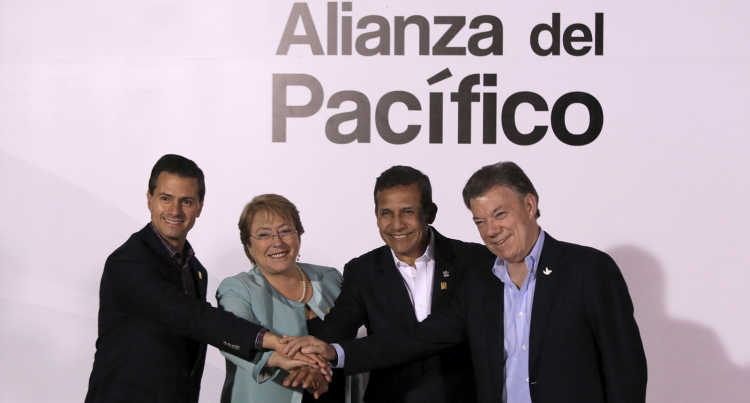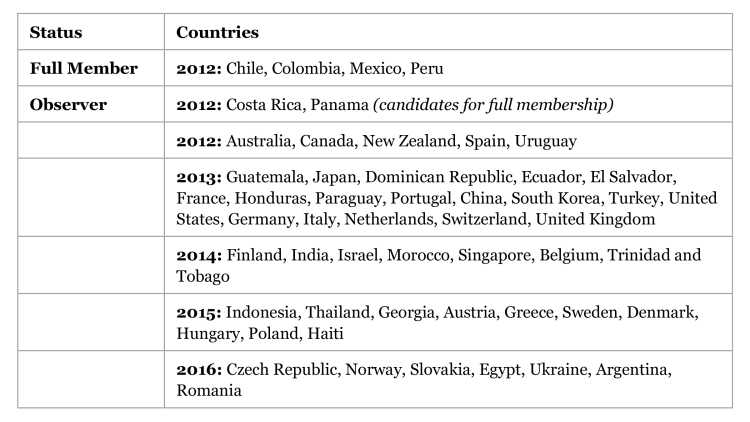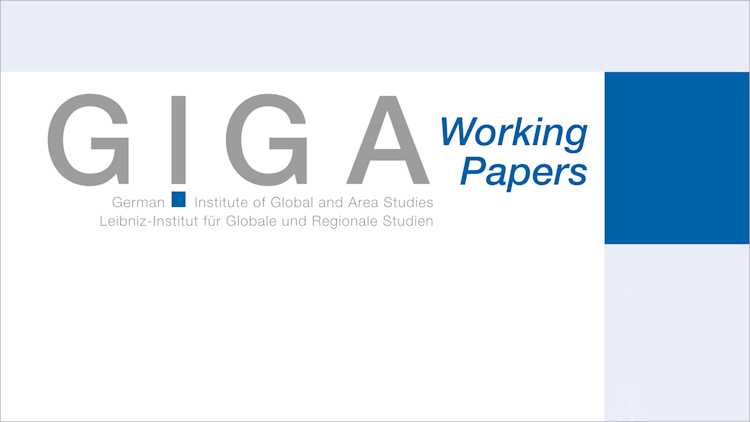- Startseite
- Publikationen
- GIGA Focus
- The Pacific Alliance: Nation-Branding through Regional Organisations
GIGA Focus Lateinamerika
Die Pazifikallianz: "Nation Branding" durch Regionalorganisationen
Nummer 4 | 2016 | ISSN: 1862-3573

Am 1. Juli 2016 trafen sich die Präsidenten Chiles, Kolumbiens, Mexikos und Perus in Puerto Varas (Chile) zum XI. Gipfeltreffen der Pazifikallianz (PA). Die Mitgliedsländer der PA praktizieren sehr erfolgreich ein gemeinsames „Nation Branding“, um ihren internationalen Status und ihre Sichtbarkeit zu steigern und Handel und Investitionen zu fördern. Seit ihrer Gründung im Jahr 2012 hat die PA das Interesse von Staaten und Unternehmen in der ganzen Welt auf sich gezogen.
Die PA ist im Wesentlichen eine wirtschaftsstrategische Allianz, um die gemeinsamen Interessen ihrer lateinamerikanischen Mitgliedsländer gegenüber den USA und Europa sowie insbesondere in Asien geltend zu machen und zu fördern.
Dies erklärt, warum die PA sehr viel mehr Staaten mit Beobachterstatus (49) als Mitglieder aufweist. Zu den Beobachterstaaten gehören wirtschaftliche Schwergewichte wie Japan, China, Deutschland, Frankreich, Großbritannien und die USA, aber auch drei von fünf Staaten des Mercosur und ein Mitglied der ALBA.
Durch ihre Agenda der Handelsliberalisierung unterscheidet sich die PA von anderen lateinamerikanischen Regionalorganisationen wie Mercosur oder ALBA und bringt eine neue Dynamik in die wirtschaftliche Integration Lateinamerikas. Zudem hat sie Mexiko als externen Akteur in das südamerikanische Regionalsystem zurückgebracht.
Aus geopolitischer Perspektive stärkt die PA die Hinwendung Südamerikas zum Pazifik und die wirtschaftlichen Verbindungen zu Asien. Überdies verschafft sie der US-Regierung neue Möglichkeiten, ihre Freihandelsagenda in Lateinamerika zu verbreiten, und dies zu einem Zeitpunkt, an dem die USA neues Interesse an Lateinamerika zeigen.
Fazit
Die vier Mitgliedsländer der PA haben sich selbst als Tor nach Asien und als die „guten Volkswirtschaften“ im Vergleich zu den „schlechten Volkswirtschaften“ anderer, mehr staatsorientierter Regierungen in Lateinamerika „vermarktet“. Mit dem augenblicklichen Rechtsruck in der Region könnte die PA an Einfluss gewinnen und die Handelsliberalisierung in Lateinamerika vorantreiben. Entsprechend könnte auch die EU aufgrund ihrer engen Kooperation mit den PA-Staaten und der mit ihnen geschlossenen Freihandelsabkommen über stärkere Hebel in ihren Beziehungen zu Lateinamerika verfügen.
The Pacific Alliance
On 6 June 2012 the presidents of Chile, Colombia, Peru, and Mexico signed the Constitutive Treaty for the Pacific Alliance (Acuerdo Marco de la Alianza del Pacifico) in Antofagasta, Chile. As conditions for membership, the Pacific Alliance (PA) framework agreement requires that PA member countries are democracies, comply with the rule of law, practise the separation of powers, respect human rights, and guarantee fundamental liberties (article 2). As outlined in the various PA declarations, the primary goal of this new regional group is to build a zone of deep economic integration and progress towards the free movement of goods, services, capital, and people. A supplementary agreement (Protocolo Adicional al Acuerdo Marco de la Alianza del Pacífico) that was signed in Cartagena in February 2014 and came into force in May 2016 specified that tariffs would be eliminated for 92 per cent of their mutual trade. The remaining 8 per cent of tariffs – which apply to politically sensitive sectors such as agriculture, textiles, and garments – will gradually be removed over a period of three to seven years. For a small percentage of these products (which are considered sensitive products), this could take up to a maximum of 17 years.
Business associations and financial markets have been supportive of the new organisation from the beginning. A Deutsche Bank Research publication (2013) championed the PA countries as “Latin America’s new stars,” while the Bertelsmann Foundation referred to them as “the Pacific Pumas” (George 2014) and later called for a “Pacific Alliance 2.0” (Marczak and George 2016). The Economist called on other Latin American countries to “join the club” (29 April 2013), which an article in Money Week (2 April 2013) described as “a new Latin American superpower.”
PA member countries (i) represent 37 per cent of the Latin American population and 35 per cent of the nominal gross domestic product (GDP) (38 per cent at PPP), (ii) account for 46 per cent of Latin American exports and 50 per cent of imports, and (iii) received 47 per cent Latin American foreign direct investment (FDI) in 2013 and 43 per cent in 2014 (Villareal 2016: 10). Accumulated GDP would make the PA the eighth most important economy in the world and the seventh largest exporter. However, the total figures for the PA are strongly influenced by Mexico, which accounts for 57 per cent of the PA population, 61 per cent of PA GDP, and 70 per cent of PA exports (Villareal 2016: 9–10). Mexican exports to the United States alone account for more than 50 per cent of the total value of PA exports. From that perspective, the PA is Mexico plus Chile, Colombia, and Peru.
The PA has had other achievements and has additional objectives. First, it integrated the stock markets of Chile, Colombia, and Peru to create the Latin American Integrated Market (MILA) in 2011; Mexico joined MILA in 2014. (MILA, however, is still very much a work in progress.) Second, since the end of 2012, visas have no longer been required for travel within the PA. Third, PA member countries have started to share diplomatic and consular representation abroad, with joint embassies now operating in Ghana (Chile, Colombia, Mexico, and Peru), in Vietnam (Colombia and Peru), in Morocco (Chile and Colombia), in Algeria (Chile and Colombia), in Azerbaijan (Chile and Colombia), and at the Organisation for Economic Co-operation and Development (OECD) in Paris (Chile and Colombia). Fourth, PA member states have started to coordinate trade and investment promotion activities (including joint promotion agencies in third countries) in order present the alliance as an integrated economic space. Fifth, the PA has established a joint student scholarship programme.
Like most Latin American regional organisations, the PA has not created supranational institutions. What is more, it has opted for a much leaner institutional structure than Mercosur or even UNASUR. The PA has no permanent secretariat or administrative body to support decision-making. The member states’ foreign ministers and trade ministers constitute the Council of Ministers, which holds ordinary meetings once a year and extraordinary meetings upon members’ requests. In line with the intergovernmental character of the group, Council of Ministers decisions must be unanimous. The PA presidency is pro tempore (one year) and rotates between member states in alphabetical order. The presidential summits are the supreme decision-making forums and are vital in moving the integration process forwards. Between April 2011 and July 2016, 12 summits were held, including a “virtual summit” by videoconference in March 2012. The PA has also created additional internal institutions such as the Parliamentary Monitoring Commission of the Pacific Alliance (Comisión de Seguimiento Parlamentario al Acuerdo de la Alianza del Pacífico) – which meets biannually and is composed of eight congress members from each member state who are appointed for a period of four years according to the rules of their national parliaments (Tvevad 2014: 9) – and the Business Council (Consejo Empresarial), which has the aim to engage the business sector with the PA.
Although the PA has a lean structure, it is nevertheless quite dynamic in regard to joint activities. For example, besides other consultations, in 2015 it organised five meetings of the so-called High Level Group (Grupo de Alto Nivel), which is composed of the vice ministers of trade and foreign affairs and is responsible for overseeing the progress of technical groups. These technical groups had three meetings in 2015. Meanwhile, the Council of Ministers met twice; the ministers of finance, three times; and the ministers of culture, once (Alianza del Pacifico 2015).
Few Members, Many Observers
The PA is, in principle, open to integrating more members. However, full memberships will only be granted to candidates that already have a free trade agreement (FTA) in place with each PA member state, which was the case with regard to the four founding members. On this basis, Costa Rica applied for full membership in February 2014 when President Laura Chinchilla signed a declaration of intention – though the process has become protracted. Panama became a candidate for full membership after the government signed an FTA with Mexico in April 2014, though the ratification of its FTA with Colombia has been delayed due to an ongoing dispute between both countries before the World Trade Organization.
Thus as of July 2016 the PA only had four full members, two observer state candidates, and 47 observer states. It is one of the few international organisations where observer states clearly outnumber member states. With regard to geographical distribution, there are 10 observer states in Latin America and the Caribbean (plus two observer state candidates), 2 in North America (Canada and the United States), 9 in Asia-Pacific (including Australia and New Zealand), and 22 in Europe (including Ukraine and Georgia), 2 in North Africa (Morocco and Egypt), and 2 in the Middle East (Israel and Turkey). The PA is of special interest for European investors and governments because the European Union has signed FTAs with all founding members of the PA as well as with Costa Rica and Panama. The intention to cooperate with the PA can be seen as a sign of confidence in the new organisation. Even three Mercosur countries (Argentina, Paraguay, and Uruguay) and one ALBA country (Ecuador) have successfully applied for observer status.
Moreover, the PA has also entered into dialogue with other regional organisations such as Mercosur, the European Union, the Association of Southeast Asian Nations (ASEAN), and the Asia-Pacific Economic Cooperation (APEC) forum.

The high number of observers can be interpreted as an indicator of success because it demonstrates the importance other states attach to the PA. However, it also confronts the PA with the challenge to take advantage of this interest and to engage with its observer states. Otherwise, there is a risk that observer status will become merely symbolic. There is also the possibility that observers may lose interest in the PA. Thus, perhaps it will be necessary to differentiate between observer state categories and to develop different cooperation mechanisms (Marczak and George 2016). The PA is reacting to this challenge and intends to structure dialogue and cooperation with observer states along four thematic axes: education; science, technology, and innovation; internationalisation of small and medium-sized enterprises; and trade facilitation. Moreover, a first PA cooperation forum with observer states is in the making.
Limited Intraregional Trade
Trade between PA member states has not significantly increased since the alliance was created. In 2014 PA intraexports (as percentage of total exports) varied between 9.1 per cent in the case of Peru and 2.1 per cent in the case of Mexico; this is not really surprising due to the heavy dependency of Mexican trade on the United States. From 2012 to 2014 only Peru’s PA exports (as a percentage of total exports) increased; in the other three countries they stagnated or decreased. Intrabloc trade (exports) would slightly increase from 5.6 per cent to 8.6 per cent by including Costa Rica and Panama in the PA.
In the PA it is not only member state trade patterns that vary; the expectations among business people also differ. In a survey of 120 businesspeople from Chile, Colombia, Peru, and Mexico published by PricewaterhouseCoopers (2014) expectations with regard to the PA were high in Colombia and Peru, more measured in Mexico, and less enthusiastic in Chile. Moreover, opinions on which industries were the most attractive for investment varied greatly in the four countries (though there was a certain consensus with respect to energy), reflecting differences between the economies of the PA countries.
The absence of economic complementarities between the member countries is an obstacle to increasing trade within the PA. Moreover, geographical distance and inadequate transport infrastructures constitute another barrier to increased trade or the creation of intraregional value chains. Thus, the declared objective of the free movement of services and capital might prove more important than growth in the intraregional trade in goods (Tvevad 2014: 14). And the PA may reinforce member countries’ positions in third markets but not necessarily in Latin America. Compared with the Mercosur countries, only a modest share of PA member countries’ exports are to Latin America.
The Pacific Alliance and the Trans-Pacific Partnership (TPP)
On 4 February 2016 in Auckland, New Zealand, 12 Pacific Rim countries signed a broad trade agreement called the Trans-Pacific Partnership (TPP) – though it still needs to be ratified by the respective national parliaments. Among the signatory countries, which account for almost 40 per cent of world GDP, are three members of the Pacific Alliance: Chile, Mexico, and Peru. The other signatories are Australia, Brunei, Canada, Japan, Malaysia, Mexico, New Zealand, Singapore, the United States, and Vietnam. Given the number of APEC countries involved in the TPP negotiations, the United States sees the TPP as an alternative way to achieve the unrealised APEC goals regarding free and open trade and investment for industrialised countries in 2010 and for developing economies in 2020, which were set in Bogor, Indonesia, in 1994 (Dade and Meacham 2013; Gateway House 2013).
The only PA country not participating is Colombia, but it might be invited to join later. The Colombian government had asked to participate in the negotiations back in 2014, but the TPP negotiations were limited to APEC members. Chile was from the beginning one of the drivers behind the TPP. In one respect, the TPP agreement is the continuation, expansion, and deepening of the Transpacific Economic Partnership Agreement, which was signed by Brunei, Chile, Singapore, and New Zealand in 2005 and entered into force in 2006. This agreement contained an accession clause for other countries. TPP negotiations started in 2008 and saw some contentious issues arise in regard to intellectual property rights (e.g. generic drugs), agriculture, rules of origin, rules for state-owned enterprises, and investor–state arbitration.
The TPP aims at comprehensive market access for its signatories by eliminating or reducing tariff and non-tariff barriers across the full spectrum of trade, including goods and services. One of the main benefits of the TPP will be the accumulation of origin rules, which may facilitate integration into global supply chains. The participating Latin American countries hope that the TPP will provide opportunities to attract investment and to insert their companies into global value chains and, in the case of PA member states, deepen and expand existing regional supply chains. Of the PA member countries, Mexico might take most advantage of the TPP because it already has a diversified manufacturing sector closely integrated into those of other North American Free Trade Agreement (NAFTA) countries. However, because NAFTA has a higher rule of origin threshold than TPP, the Mexican automobile industry could also become exposed to more competition from Asia. For the other PA countries, the effect of the TPP may be more limited. Their principal export products are commodities and most PA member states already have FTAs in force (or they are in the process of negotiating FTAs) with the other TPP countries. There might be negative effects for Central American countries with significant apparel and textile industries because of increased competition from Vietnam. In South America TPP will reinforce the existing divisions between economies based on exports and market-oriented growth strategies, on the one hand, and the more closed, protected, and state-led economies, on the other hand (Wilson 2015). From a broader perspective, with their open economies and free trade agendas, the PA countries seem to be better prepared for the challenges of mega-regional trade agreements such as TPP and the Transatlantic Trade and Investment Partnership (TTIP) (Heine 2016).
PA: A Strategic Alliance or a Group of Status Seekers?
Although PA member countries share economic interests that are not contingent upon their incumbent governments, the same is not true in regard to political strategic issues. The economic agendas of the Chilean, Colombian, Mexican, and Peruvian governments coincide and overlap to a high degree. The four countries are in favour of FTAs, an open economy, and closer economic cooperation with Asian and Pacific countries. It is remarkable that in all four countries the basic parameters of economic policy are not questioned whoever is president.
While they share similar economic interests, the common denominators of the PA countries in other issue areas such as security issues are not so clear. Peru and Chile still have pending disputes regarding their maritime borders. The Chilean government of Michelle Bachelet has a strong South American political agenda. And the PA member countries are confronted with different domestic security challenges (e.g. consolidation of the peace process in Colombia and drug-related crime in Mexico). Furthermore, PA countries’ security agendas are determined by the (sub)regional context. For instance, Mexico’s security agenda is closely linked to that of the United States. In contrast, the three South American PA member states have created their own security architecture with the Union of South American Nations (UNASUR) and the South American Defense Council at its core. Quite interestingly, on one occasion the PA members acted as a coalition at an international forum. In August 2015 the Permanent Mission of Colombia at the Organization of American States (OAS) requested that a meeting of consultation of the ministers of foreign affairs be convened in order to consider “the humanitarian situation of Colombian citizens in the Bolivarian Republic of Venezuela in light of the recent deportations, which has been brought about by the way in which those Colombian citizens are being deported from and forced to leave the Bolivarian Republic of Venezuela.” The meeting of the Permanent Council took place on 31 August 2015. The request for a meeting of the foreign ministers would have needed the support of an absolute majority of the 34 member countries, 18 votes. But it received only 17 votes. However, all the PA countries (4) plus Costa Rica (a PA candidate country) voted in favour. Moreover, on 22 June 2016 all four PA countries plus both PA candidate states (Costa Rica and Panama) voted in favour (in total 20 states were in favour; 12 against; and 2 abstained) of discussing in the OAS the application of the democracy clause in the case of Venezuela – something the Venezuelan government tried to prevent.
Nevertheless, one might still question whether the PA is really a strategic alliance – that is, whether it is based on common strategic objectives. There are alternative explanations for the objectives PA member countries pursue through the alliance. For some, the PA can be interpreted as a “minilateral” instrument of joint status-seeking or status enhancement in international politics. Paul, Larson, Paul, and Wolforth (2014) define status as “collective beliefs about a given state’s ranking on valued attributes” and argue that “in international politics, status manifests itself in two distinct but related ways: as membership in a defined club of actors, and as relative standing within such a club.”
The four PA member countries have created an exclusive free-trader club (only countries with a FTA with all member states can join in the future) and “branded” the new organisation as an alliance of states with open markets, rule of law, guaranteed property rights, and dynamic economies that acts as a gateway to Asia. In a nutshell PA members present themselves as the “good guys” or “good economies” compared to the “bad guys” or “bad economies” of ALBA and other more state-oriented Latin American economies. Moreover, the PA members practise a form of joint “nation-branding” with the objective of promoting trade and investment. From this perspective, the PA cumulates the achievements of the individual countries with regard to trade liberalisation and FDI-friendly policies. The joint marketing of these accomplishments is the value added of the PA (Levi and Reggiardo 2016: 200).
A good example of this “branding strategy” is a joint article by the four presidents of the PA countries in the Spanish newspaper El País (8 October 2013) in which they declared that their trade agreement constitutes “a robust institutional and judicial framework that creates certainty for investments and free trade.” Three years later in the Declaration of Puerto Varas (1 July 2016), the presidents of the PA countries made reference to the activities of the PA finance ministers “to disseminate the image of the region as an attractive destiny for investments” and to recognise the contribution they make in consolidating the PA brand (“la marca Alianza del Pacifico”). The high number of observer states in the PA can be interpreted as an indicator that the PA countries have been successful with their status-seeking and branding strategy.
Only a few months after the PA’s creation, the PA members took the opportunity at the European Union–Community of Latin America and Caribbean States Summit in Santiago de Chile (26–27 January 2013) to promote their new alliance and to court European investors with the promise of open markets and legal certainty. The PA’s advances were well received by the former president of the European Council, Herman van Rompuy, who described the PA “as a very promising initiative that brings together countries which share the European Union’s views on open markets and modern economic policies, and which aims at creating an economic space similar to our own, based on the four freedoms of circulation of goods, capital, services, and persons.” In May 2013 the European Union was a special guest at the PA summit in Cali, Colombia, and in November 2013 government representatives and business organisations from PA member countries went on a promotional tour in Europe, stopping in Hamburg, Rome, Warsaw, and Helsinki.
During the United Nations General Assembly in New York in September 2015, the presidents of the PA, along with their finance and trade ministers, attended an event organised by the Financial Times and the PA Business Council to advertise the investment opportunities their countries can offer. In conjunction with the event, the Financial Times also published a special report on investing in PA countries (28 September 2015). The New York event was initially planned to be the first stop of a PA roadshow, but trips to London and Singapore never came to fruition. However, the PA member countries have carried out other high-profile joint activities. For example, on 7 March 2016 the PA members’ finance ministers held a joint press conference in New York to highlight common denominators between the four countries: fiscal responsibility, clear institutional frameworks, and sound financial policies.
There have also been coordinated activities by the PA countries’ trade-promotion agencies (ProChile, ProColombia, ProMéxico, and PromPerú), such as the opening of joint trade-promotion offices in Istanbul (2012) and Casablanca (2013), conducting joint presentations at trade fairs in Europe and Asia (especially in the food and tourism sectors), holding an annual trade fair called the Pacific Alliance Business Matchmaking (Macrorrueda de Negocios de la Alianza del Pacífico) for member-country companies (2013 in Cali, Colombia; 2014 in Puerto Vallarta, Mexico; 2015 in Paracas, Peru; 2016 in Santiago de Chile, Chile), and organising the PA’s first business forum (Day of the Pacific Alliance) in Monterrey, Mexico, in March 2016. One should also mention that in October 2015 both the Frankfurt and London stock exchanges held a MILA Day, in which representatives of the stock exchanges of the four PA countries participated.
While the PA is based on a strategy of joint “nation-branding” and status-seeking, one has to differentiate between the salience the PA has for the four countries. The incentives for this joint endeavour are more pronounced in Colombia and Peru than in the other two PA countries. Chile has a registered “brand” as a free trader and open economy and also complies with high democratic standards. So in the case of Chile the affiliation with the PA group is part of an integral strategy to cooperate economically with many partners (political cooperation within the PA is less important). It may also be part of a strategy to join a group of countries with a similar “brand” instead of competing against them. In the case of Mexico the political strategic motives might be more important than the economic and “branding” motives. The PA gives Mexico a foothold in South America. As an emerging power it has now also created an exclusive club in which it decides on the admission criteria. Moreover, it is a club which discriminates (because of its objectives and membership rules) against Brazil and other South American countries. Perhaps Colombia and Peru are the countries most interested in the PA as an instrument of status-seeking and “nation-branding.” Both countries are members of the languishing Andean Community, which has lost appeal for external partners and both are confronted with domestic political challenges which, from time to time, have a negative impact on how the countries are perceived from the outside. However, both countries also have great economic potential and are trying to position themselves in the regional context, looking for the right role model to enhance their international status.
Geopolitical Implications
What geopolitical implications does the PA have for Latin America and especially for South America? Does the PA affect the regional integration and cooperation dynamics? From a geopolitical perspective, the PA has generated a new dynamic of soft balancing in Latin America. Although the PA excludes Brazil (though this regional power has shown no inclination to join the endeavour), it has revived Mexico as an external actor in the South American regional subsystem. Mexico had lost its influence in the region in the early 1990s when it shifted its foreign policy priorities to NAFTA. Although Mexico has emphasised the commercial dimension of the PA, countries such as Chile and Colombia perceive Mexico’s involvement as an opportunity to soft balance Brazil’s influence in South America. From a geopolitical perspective, Mexico sees the new alliance as important to it becoming more influential in Latin America and South America in particular (Tokatlian 2013). The foreign minister highlighted some of these strategic interests in his foreword to the PA-focused special issue of Revista Mexicana de Política Exterior published by the Mexican Foreign Ministry in the first semester of 2016.
Even though there is an economic bifurcation in South America between free trade–oriented countries and more protectionist countries, the risks to regional governance might be overstated. For example, the Chilean government of President Bachelet argued from the beginning in favour of a process of convergence of the PA and Mercosur. In November 2014 the foreign ministers of the Mercosur and the PA countries held their first joint meeting in Cartagena, Colombia. During that same month, President Bachelet opened the seminar “Diálogo sobre Integración Regional: Alianza del Pacífico y Mercosur” (Dialogue on regional integration: Pacific Alliance and Mercosur) in Santiago de Chile, which was attended by ministers, political representatives, and academics from Mercosur and the PA, as well as by representatives of other international organisations, such as the Latin American Integration Association (ALADI), the CAF Development Bank of Latin America, the Inter-American Development Bank (IDB), the OAS, and the Association of Caribbean States (ACS). The Economic Commission for Latin America and the Caribbean (ECLAC) even presented a study titled “La Alianza del Pacífico y el MERCOSUR. Hacia la convergencia en la diversidad” (The Pacific Alliance and Mercosur. Towards convergence in diversity) at the seminar in Santiago de Chile. Since the 47th Mercosur Summit in Paraná (December 2014), all summit declarations have included a statement in favour of closer cooperation with the PA. In 2015 the Brazilian government also began to take a more active stance regarding the rapprochement between the PA and Mercosur, which may be reinforced by the current Brazilian foreign minister, José Serra. Moreover, with the election of Mauricio Macri as president of Argentina in November 2015, the Argentinean government has adopted a strong pro-cooperation stance (which is in contrast to the country’s position under the former president, Christina Fernandez de Kirchner) and even became a PA observer state in 2016. Furthermore, President Macri participated as a special guest at the PA summit in Puerto Varas and was the keynote speaker at the Third PA Business Summit in Puerto Montt, Chile. During his visit to Chile, Macri argued in favour of greater dynamism within Mercosur and the ultimate objective of a convergence of Mercosur and PA (Cué 2016a). Despite supporting this approach in principle, President Bachelet prefers a “convergence in diversity” (“la convergencia en la diversidad”) (Cué 2016b).
These developments demonstrate that the PA has brought “a breath of fresh air” to the region (Heine 2016) and has added a new dynamic to South American economic integration. The PA could help to advance trade liberalisation. And because some Mercosur countries are interested in individual FTAs with the PA countries, the PA could help to subvert the customs union of Mercosur, which could end up perforating or even abolishing Mercosur’s common external tariff. Consequently, the PA is increasing the centrifugal forces within Mercosur. In fact, President Macri’s visit to the PA summit in Puerto Varas could be construed as signifying that the PA has won the “ideological battle” against Mercosur in regard to the preferred economic development model in South America and is now luring Mercosur countries to join the club. Although neither organisation overlaps in terms of their mandates and objectives, they are competing for leadership in Latin America with a view to both the regional community and external actors.
From a broader geopolitical perspective, the PA strengthens the Pacific shift in South America and the economic link with Asia. Furthermore, it offers the US government new opportunities to promote its free trade agenda in Latin America at a time when Washington is showing renewed interest in Latin America. The PA can also be seen as part of the geopolitical and geoeconomic dynamics that are evolving in the Asia-Pacific region (such as TPP) and the great-power competition between China and the United States. Likewise, the European Union may obtain more leverage in its relations with Latin America through its close cooperation and FTAs with the PA countries. This might be helpful in the negotiations for a FTA with Mercosur. The PA might put pressure on countries without FTAs with the European Union (such as Brazil), especially if EU–US negotiations over the TTIP advance. Such an agreement might benefit the PA countries as they already have FTAs with both the European Union and the United States. The differentiated multilateral cooperation patterns in Latin America open up more access points for external actors such as the European Union. The variable geometry of internal and external cooperation diminishes the risk of stagnation in interregional relations between Europe and Latin America. However, it also makes Latin America more porous with regard to external influences.
Outlook
How the PA develops in the midterm will show the real importance of this still relatively new alliance and answer the question of whether the PA has been overselling its advances and potential. The PA has been a great marketing success, but now the customers have to decide whether the product corresponds to their expectations. Moreover, as time passes, even the most successful marketing campaigns lose steam. At that point, the product might need a fresh promotion strategy or a rebranding. A recent analysis argues that “the greatest challenge for the Pacific Alliance is living up to expectations” (Dade and Meacham 2013: 11). This rings especially true when it comes to implementing the trade liberalisation agenda – particularly regarding the 8 per cent of trade currently still subject to tariffs. Another issue is that the PA might be overrated in terms of its economic strength and cooperation potential (e.g. intratrade in the PA is quite limited), which could thus make it unable to live up to expectations.
Despite all of this, the PA constitutes an interesting political experiment. It demonstrates that middle powers (Mexico) and regional secondary powers (Colombia and Chile) can cooperate and create regional organisations with the objective to enhance their international status by practising joint nation-branding. From this perspective, the PA represents a new type of regional alliance which both transcends and challenges traditional regional organisations. With Mexico already working with three member states from the South American regional subsystem, the potential inclusion of Costa Rica and Panama would see the PA build a bridge connecting the South American, Central American, and North American subsystems. Moreover, with its outreach strategy to other regions, especially Asia, the PA deviates from traditional regionalism. It is also much more outward oriented than “open regionalism” which was in vogue in the 1990s. The PA might be more suitable to a multipolar political economy in the international system, where the economic and trade-related dimensions of regionalism are becoming less important than the political and security dimensions. With regard to trade, many states prefer a cross-regional strategy (Garzon 2015) based on the diversification of trade partners and FTAs with countries in other regions. It will be interesting to see whether other like-minded governments in other world regions attempt to emulate the PA.
Fußnoten
Literatur
Alianza del Pacifico (2015), Lo más destacado de la Alianza del Pacífico en el 2015, https://alianzapacifico.net/wp-content/uploads/2016/01/Recuento_2015AP.pdf (7 August 2016).
Alianza del Pacifico (2016), Declaracion de Puerto Varas, 1 July, www.cancilleria.gov.co/sites/default/files/declaraciondepuertovaras.pdf (7 August 2016).
Cué, Carlos E. (2016a), La Alianza del Pacífico consagra el giro político de Latinoamérica, in: El País, 30 June, http://internacional.elpais.com/internacional/2016/07/01/america/1467394269_444854.html (7 August 2016).
Cué, Carlos E. (2016b), La crisis de la política es universal: Tenemos que replantearnos todo, interview with the Chilean president Bachelet, in: El País, 2 July, http://internacional.elpais.com/internacional/2016/07/01/america/1467394269_444854.html (7 August 2016).
Dade, Carlos, and Carl Meacham (2013), The Pacific Alliance: An Example of Lessons Learned, Washington, D.C.: CSIS.
Deutsche Bank Research (2013), Talking Point: The Pacific Alliance – Latin America’s New Stars (27 August 2013).
ECLAC (2014), La Alianza del Pacífico y el MERCOSUR: Hacia la convergencia en la diversidad, Santiago de Chile: ECLAC.
European Council, The President (2013), Remarks by President of the European Council Herman Van Rompuy after his Meeting with President of Colombia Juan Manuel Santos and President of Peru Ollanta Humala, 27 January, www.consilium.europa.eu/uedocs/cms_data/docs/pressdata/en/ec/135037.pdf (25 October 2013).
Garzon, Jorge (2015), Latin American Regionalism in a Multipolar World, EUI Working Paper RSCAS 2015/23, Florence: European University Institute.
Gateway House (2013), The Pacific Alliance: ASEAN’s Bridge to South America, ASEAN Briefing, (26 November 2013).
George, Samuel (2014), The Pacific Pumas: An Emerging Model for Emerging Markets, Washington, D.C.: Bertelsmann Foundation.
Heine, Jorge (2016), Sigla nueva en sopa de letras: raíces y ramificaciones de la Alianza del Pacífico, in: Revista Mexicana de Política Exterior, 106, 35–48.
Leví Coral, Michel, and Giulliana Reggiardo (2016), La Alianza del Pacífico en el regionalismo sudamericano actual, in: Revista Mexicana de Política Exterior, 106, 187–204.
Marczak, Jason, and Samuel George (2016), Pacific Alliance 2.0: Next Steps in Integration, Washington, D.C.: Atlantic Council and Bertelsmann Foundation.
McKeigue, James (2013), The Pacific Alliance: A New Latin American Superpower, in: Money Week, 2 April, http://moneyweek.com/pacific-alliance-a-new-latin-american-superpower-63300/ (20 April 2016).
Paul, T. V., Deborah Welch Larson, and William C. Wohlforth (eds) (2014), Status in World Politics, New York: Cambridge University Press.
PwC México (2014), La Alianza del Pacífico: Una nueva era para América Latina, México.
Tokatlian, Juan Gabriel (2013), ¿Cuán poderoso es Brasil?, in: Foreign Affairs Latinoamérica, 13, 1, 25–31.
Tvevad, Jesper (2014), The Pacific Alliance: Regional Integration or Fragmentation?, Policy Briefing, Brussels: Policy Department, Directorate-General for External Policies.
Villarreal, M. Angeles (2016), The Pacific Alliance: A Trade Integration Initiative in Latin America, CRS Report, R43748, Washington, D.C.: Congressional Research Service.
Wilson, Christopher (2015), The Impact of TPP on Latin America and U.S. Relations with the Region, Washington, D.C.: Wilson Center, www.wilsoncenter.org/article/the-impact-tpp-latin-america-and-us-relations-the-region (7 August 2016).
Gesamtredaktion GIGA Focus
Redaktion GIGA Focus Lateinamerika
Regionalinstitute
Forschungsschwerpunkte
Wie man diesen Artikel zitiert
Nolte, Detlef (2016), Die Pazifikallianz: "Nation Branding" durch Regionalorganisationen, GIGA Focus Lateinamerika, 4, Hamburg: German Institute for Global and Area Studies (GIGA), http://nbn-resolving.de/urn:nbn:de:0168-ssoar-47994-2
Impressum
Der GIGA Focus ist eine Open-Access-Publikation. Sie kann kostenfrei im Internet gelesen und heruntergeladen werden unter www.giga-hamburg.de/de/publikationen/giga-focus und darf gemäß den Bedingungen der Creative-Commons-Lizenz Attribution-No Derivative Works 3.0 frei vervielfältigt, verbreitet und öffentlich zugänglich gemacht werden. Dies umfasst insbesondere: korrekte Angabe der Erstveröffentlichung als GIGA Focus, keine Bearbeitung oder Kürzung.
Das German Institute for Global and Area Studies (GIGA) – Leibniz-Institut für Globale und Regionale Studien in Hamburg gibt Focus-Reihen zu Afrika, Asien, Lateinamerika, Nahost und zu globalen Fragen heraus. Der GIGA Focus wird vom GIGA redaktionell gestaltet. Die vertretenen Auffassungen stellen die der Autorinnen und Autoren und nicht unbedingt die des Instituts dar. Die Verfassenden sind für den Inhalt ihrer Beiträge verantwortlich. Irrtümer und Auslassungen bleiben vorbehalten. Das GIGA und die Autorinnen und Autoren haften nicht für Richtigkeit und Vollständigkeit oder für Konsequenzen, die sich aus der Nutzung der bereitgestellten Informationen ergeben.








